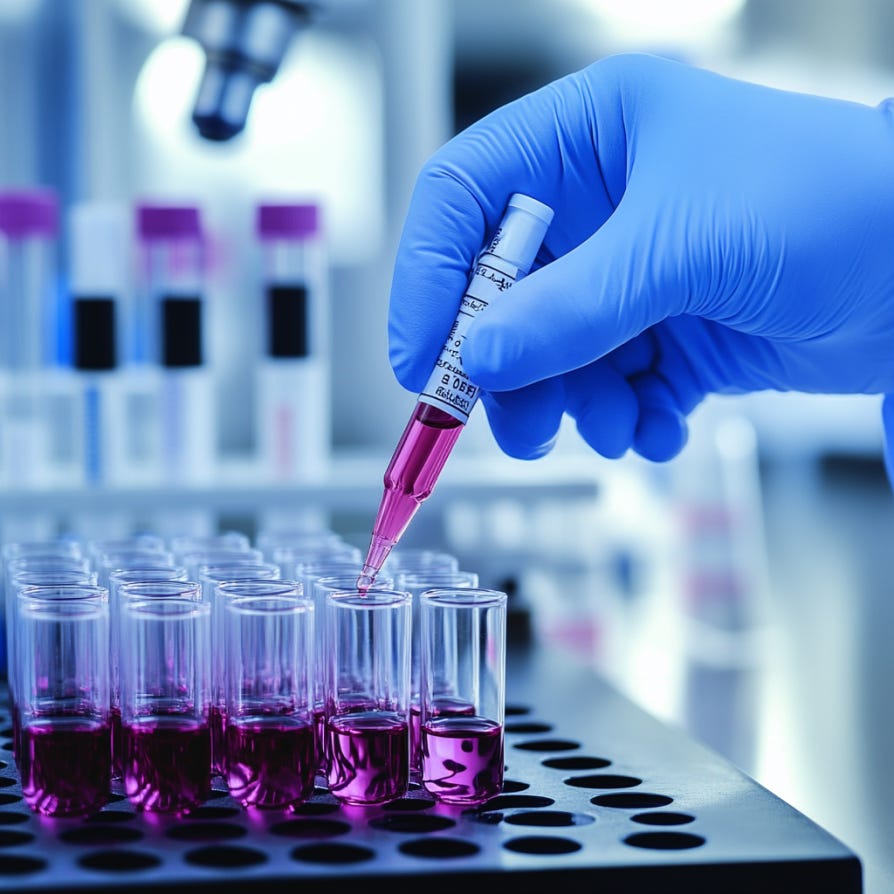Gene Editing & Therapy for Obesity (2025): Top Targets for Weight Loss, Fat Reduction, Muscle Preservation
Gene therapy/edits will eventually allow you to lose weight effortlessly and tweak your body composition like a custom video game character
Due to excessive risk-aversion, humanity hasn’t yet embraced gene editing for cosmetic enhancement and/or treating medical conditions like obesity… but they should have… this should’ve been done in the early 2010s.
And no person or “authority” (i.e. regulatory body) should get to decide whether it’s “ethical”… individuals can decide that for themselves. You don’t think it’s ethical? Then don’t do it — others should have the freedom to make a conscious decision for themselves.
But what about inequality? So what? The world is unequal. Inequality is fine. Some have access earlier because they’re rich… and this eventually helps fund more R&D and brings down the cost of treatment for others. If you try to focus on equity it slows progress and increases costs for everyone.
Think about it like iPhones… when they first came out, only the ultra-rich could afford them. Now? Everyone has one… people living in third-world countries have them… it’s due to initial funding from the rich, tech advancement, and scale.
Won’t gene editing decrease genetic diversity? Maybe a bit… and? Why is decreased genetic diversity inherently bad? Well won’t reduced diversity increase extinction risk? Not necessarily. You could argue the hypothetical that it could… I could argue the hypothetical that it may decrease extinction risk.
Additionally, we can always edit/modify genes back to baseline if we determine there are significant risks. Some may try “reversible” edits (in-built time decay or something) that serve as a vaccine that they need to re-up each year.
It may also be possible to use some sort of precision fine-tuning for each individual (modulating the magnitude of the edit for desired effect size): like a dial/knob — increase GLP-1RA if you need more weight loss… if you want more modest loss, only do a slight increase.
Just because many people might opt for gene edits to enhance aesthetics or treat obesity/overweightedness — doesn’t automatically mean decreased resilience.
We’ve long been genetically modifying plants & selectively breeding animals — and this typically increases long-term survivability/resilience. There’s still a lot of genetic diversity anyway… making a few edits doesn’t quash the entire diversity within genomes.
And we must consider that a significant percentage of the population wouldn’t get these edits. But those who have morbid obesity and aren’t responding to weight loss drugs and/or are nearing their “death bed” or are at high risk of mortality — should be offered preclinical trials in gene therapy for weight loss.
Let’s get the show on the road here… If not in the U.S. someone needs to start an offshore clinic in a country with low/no significant regulations. Human trial data = the best data. Obviously we should have proof of concept here in animals, etc. — but something like GLP-1 edits seem logical.
The Global Obesity Challenge (2025)
Obesity has become one of the most critical public health challenges worldwide. Current estimates suggest that over 650 million adults are classified as obese, according to the World Health Organization. This epidemic exacts a significant toll on both personal and systemic levels:
Metabolic Complications: Individuals with obesity are at higher risk for type 2 diabetes, dyslipidemias, nonalcoholic fatty liver disease (NAFLD), and cardiovascular disease (CVD).
Quality of Life & Economic Strain: Comorbidities such as hypertension, obstructive sleep apnea, and certain obesity-related cancers increase healthcare costs and reduce patient well-being and productivity.
Limitations of Conventional Therapies
Lifestyle Interventions (Diet & Exercise)
Foundational but frequently hindered by long-term adherence issues and high rates of weight regain once strict regimens end.
Behavioral vs. Biological: Many individuals encounter strong physiological compensatory mechanisms (appetite rebound, reduced metabolic rate) when they attempt caloric restriction.
Pharmacotherapy
GLP-1 & GIP Agonists (semaglutide, tirzepatide) have emerged as potent anti-obesity agents, often achieving 10–25% weight loss.
Drawbacks: Chronic injections, high cost, and side effects (e.g., nausea, potential risks of thyroid C-cell hyperplasia in rodents). Weight typically rebounds after cessation.
Bariatric Surgery
Gold Standard for severe obesity, yielding 20–30% weight loss, often durable, with improvements in T2D remission.
Invasive & Risky: Requires specialized surgical expertise, carries perioperative risks, can lead to chronic nutritional deficiencies, and is not accessible or acceptable to all patients.
READ: Best New Weight Loss Drugs (2025 Power Rankings)
The Rise of Gene Editing & Gene Therapies
The advent of CRISPR-Cas9 and related tools has revolutionized what’s possible in gene therapy. Traditional gene therapy has historically involved delivering a healthy copy of a gene via viral vectors, but CRISPR-based platforms permit precise interventions at defined genomic loci:
CRISPR-Cas9: Deploys a guide RNA to target specific DNA sequences for cutting, resulting in knockouts or insertion of new genetic material.
Base Editing & Prime Editing: Next-generation techniques that edit individual bases or small sequences with minimal collateral damage.
CRISPR Interference (CRISPRi) and CRISPR Activation (CRISPRa): Use a catalytically “dead” Cas9 to repress or activate target genes without cutting the DNA, reducing off-target concerns.
In tandem, viral vectors (e.g., AAV) have become safer and more specific, and lipid nanoparticle approaches are steadily improving. These delivery systems pave the way for targeted in vivo gene therapies aimed at the brain, liver, or adipose tissue—regions central to obesity’s pathophysiology.
Why Gene Editing is Intriguing for Obesity
Two major factors make gene editing a compelling strategy for obesity:
Potential One-Time or Infrequent Treatment: Instead of requiring daily or weekly administration (as with GLP-1 agonists), a gene-editing intervention could be administered once, providing long-lasting metabolic benefits. This lowers both patient burden and long-term costs compared to indefinite prescription refills.
Deeper Metabolic Reset: By directly targeting the genes that regulate appetite, fat accumulation, or energy expenditure, gene editing can reprogram an individual’s physiology at the source. This goes beyond modulating peripheral signals and may fundamentally alter a person’s susceptibility to weight gain.
Key Mechanistic Pathways
Efforts in the obesity gene-therapy space generally revolve around one or more of the following:
Central Appetite Regulation: Genes in the hypothalamus (MC4R, SIM1, BDNF, GPR75) that modulate hunger and satiety.
Endocrine/Hormonal: GLP-1, FGF21, GDF15, etc., controlling appetite and energy expenditure systemically.
Adipose Tissue: Genes that limit fat storage (FABP4, INHBE) or enhance thermogenesis (UCP1, NRIP1).
Muscle Enhancement: Blocking myostatin (GDF8) to raise basal metabolic rate via increased muscle mass.
A Pro-Enhancement Perspective
While gene therapies were once primarily reserved for severe genetic disorders, expanding their use to obesity—and potentially beyond mere disease treatment into areas of enhancement—stimulates lively debate.
However, from a pro-enhancement stance, there is every reason to view such applications as both valid and beneficial:
Individual Autonomy: If individuals can safely alter their metabolic set points or body composition to a desired goal, it aligns with the broader principle of self-determination.
Market-Driven Innovation: As with many cutting-edge technologies (smartphones, electric vehicles, etc.), initial adopters who can afford it fund further innovation, improving technologies over time and ultimately driving down prices.
Cumulative Societal Gains: Early high-cost treatments, while limited to a smaller market at first, help accelerate research, refine safety profiles, and scale up production methods—paving the way for broader accessibility in the long run.
In other words, what begins as an elite or specialized option, through market forces and iterative innovation, becomes more mainstream over time—similar to how iPhones or high-end EVs started as premium-only devices but eventually reached pretty much everyone.
Adopting a positive attitude toward enhancement fosters technological progress, increases investment in research, and hastens breakthroughs that can benefit anyone seeking improved health, physical performance, or body composition.
REMEMBER: YOU ARE NOT IN ANY POSITION TO TELL OTHERS WHAT THEY CAN/CAN’T DO WITH THEIR BODY. IF YOU DON’T WANT TO DO GENE THERAPY/EDITING, THEN DON’T DO IT. YOU DO NOT HAVE UNIVERSAL MORAL/ETHICAL AUTHORITY TO PLAY GLOBAL BIOETHICS BOSS AND TELL OTHERS WHAT THEY CAN/CAN’T DO. YES THERE ARE POTENTIALLY SIGNIFICANT RISKS, BUT PEOPLE CAN MAKE AN INFORMED DECISION AND HAVE AUTONOMY/FREEDOM.
But it’s not natural! Don’t succumb to the “appeal to nature fallacy.”
If you are reading this you are doing something unnatural (using the internet via computer, tablet, mobile phone, etc.).
Air conditioning, fire alarms, dental care, cell phones, smoke detectors, water purification, antibiotics, motor vehicles, airplanes, etc. are all not natural.
Asbestos, cobra venom, tuberculosis, and arsenic? All natural.
I. Gene Therapy Basics for Weight Loss (Fat Loss) & Obesity Cure
A.) Permanent vs. Reversible Therapies
1. Permanent (CRISPR Knockouts, Base/Prime Editing)
Mechanism: Creating stable modifications that alter or inactivate obesity-related genes.
Nuclease-Based CRISPR: Traditional Cas9 cleavage leading to gene knockout if repaired by non-homologous end joining.
Base Editing / Prime Editing: Can correct or introduce single-nucleotide changes without large indels—particularly useful for monogenic obesity with known point mutations (e.g., certain MC4R variants).
Advantages: One-and-done solution, no repeated maintenance.
Risks: If the edit overshoots or triggers unforeseen side effects (extreme muscle growth, too little fat storage), there’s little recourse for reversal.
2. Reversible (CRISPRi, siRNA, Riboswitches)
CRISPRi (Interference): dCas9 with a repressor domain reduces target gene expression, but once therapy halts, expression can return to normal.
siRNA/RNAi: Typically repeated or periodic injections (e.g., INHBE siRNA), with effect wearing off if discontinued.
Inducible Promoters: AAV vectors that turn on/off gene expression in response to a small molecule (riboswitch).
Advantages: More cautious approach, adjustable or recallable if metabolic or side effects arise.
Drawbacks: Maintenance dosing or complexity in vector design.
B.) Local vs. Systemic Administration
1. Systemic Delivery
IV or Subcutaneous: Broad distribution. Tissue tropism is conferred by vector type or conjugates (e.g., GalNAc for hepatocytes).
Use Cases: INHBE siRNA for liver, FGF21 AAV for muscle or liver, GLP-1 gene therapy for pancreas or muscle.
Easier Scalability: Large populations can be addressed, minimal specialized procedure.
2. Localized Delivery
Hypothalamic Injection: For MC4R or BDNF gene therapy in severe monogenic obesity. Highly invasive or requires advanced BBB-crossing vectors.
Intramuscular: Targeting myostatin/activin in muscle to raise metabolism.
Ex Vivo Cell Editing: Browning adipose tissue (HUMBLE, NRIP1) or CPT1A(m) “fat furnaces,” then reimplantation. Safeguards off-target edits but more logistically demanding.
C.) Current Established Methods (2025)
AAV (Adeno-Associated Virus): Common in approved gene therapies, can yield long-term expression but limited cargo size and potential immunity issues upon re-dosing.
RNAi (siRNA, shRNA): Effective for hepatic targets, requires periodic dosing, easily reversible.
Base/Prime Editing: Offers single-base precision, beneficial for monogenic variants but not yet mainstream in obesity trials; still mostly in earlier clinical phases or preclinical for other diseases.
CRISPR-LNP: Delivers CRISPR mRNA or RNP in lipid nanoparticles, an emerging non-viral approach with less immunogenicity but limited real-world obesity data thus far.
D.) Balancing Safety, Efficacy, Complexity
Permanent Edits Suit mild or well-understood targets (partial INHBE LOF, moderate myostatin block) where the risk of overshoot is low.
Reversible Approaches Are safer for potent appetite or muscle genes (GLP-1, GDF15, strong myostatin knockouts) that may trigger extreme phenotypes if unregulated.
Systemic vs. Local: For broad obesity usage, systemic strategies (liver, muscle) are more feasible. Localized or ex vivo solutions are best for severe, specialized, or orphan scenarios.
Takeaway: Foundational gene-editing decisions—permanent vs. reversible, local vs. systemic—determine long-term risk, reversibility, cost, and practical adoption. Peripheral approaches like liver or muscle targeting are more scalable for complex, polygenic obesity, while specialized local or ex vivo methods excel in rare monogenic or refractory cases. Ongoing improvements in CRISPR specificity, vector engineering, and base/prime editing promise an increasingly precise and safe landscape for obesity gene therapy.
II. Central Appetite Regulation (Brain/CNS)
Targeting the hypothalamus
The hypothalamus orchestrates energy balance by integrating peripheral signals (leptin, insulin, ghrelin) and intrinsic neuropeptide circuits (POMC, NPY).
Dysregulations in key hypothalamic genes can lead to excessive hunger (hyperphagia) and severe, treatment-resistant obesity. While drug-based therapies ultimately influence these same pathways indirectly, gene-editing can modulate them directly and persistently.
1. MC4R / SIM1 CRISPRa
Core Mechanism: The melanocortin-4 receptor (MC4R) is a crucial satiety receptor in the hypothalamus. A single functional allele is often insufficient to maintain normal appetite, leading to monogenic obesity.
CRISPRa (CRISPR activation) employs a catalytically dead Cas9 fused to transcriptional activators, boosting expression of the remaining good copy of MC4R (or SIM1, another satiety regulator).
Preclinical Efficacy: Rodent models with MC4R haploinsufficiency typically become severely obese. After a single CRISPRa injection, these mice remained ~30–40% lighter than controls for up to 10 months, indicating a near-complete “cure” of their hyperphagia.
Administration & Challenges: Direct hypothalamic injection is invasive, suitable primarily for rare or severe cases. Advanced BBB-crossing vectors could broaden viability in the future.
Use in Common Obesity: Potential but less practical. Most obese individuals do not have a simple MC4R haploinsufficiency, and the invasive route is a high barrier compared to easier peripheral strategies.
2. BDNF Gene Therapy
Role of BDNF: Brain-Derived Neurotrophic Factor supports neuronal health and plasticity. In the MC4R pathway, it acts downstream to reinforce satiety signals.
Therapeutic Logic: Where MC4R signaling is inadequate (monogenic deficiency), extra BDNF in the hypothalamus can compensate, restoring the satiety loop.
Autoregulatory Promoters: Some AAV vectors use gene circuits that taper BDNF expression once normal weight is reached, reducing overshoot risk.
Primary Targets: Severe genetic obesity with partial or full MC4R dysfunction. For broader obesity, the same invasiveness concerns apply: BDNF therapy is typically delivered via direct or highly specialized CNS routes.
3. GPR75 Inactivation
Discovery: Large-scale human genetic studies found that GPR75 loss-of-function variants confer ~12 pounds lower weight on average, suggesting a “thrifty” receptor that promotes weight gain when active.
Hypothalamic Expression: GPR75 localizes to neurons in the hypothalamus, implying gene knockout or partial silencing could recapitulate this leanness.
Research Status: Companies like Regeneron are investigating small molecules or siRNAs to block GPR75. CRISPR-based knockout is conceptual, limited by BBB or local injection.
Potential: Possibly safer than BDNF/MC4R fixes if moderate effect size (~5–10%), but still requires specialized CNS-targeted delivery.
Safety, Mood, Ethical Concerns
Potential Mood Effects: Over-suppressing appetite via direct hypothalamic edits might alter reward pathways, though rodent data have not shown major issues.
Invasiveness: Intracranial injection or advanced BBB-penetrating vectors remain more complex than typical IV or subQ deliveries.
Optimal Use Case: Rare or monogenic childhood obesity unresponsive to peripheral therapies. In the future, noninvasive vectors might make it viable for broader obesity, but at present it’s overshadowed by simpler hormonal/liver or muscle approaches.
Takeaway: Central gene edits (MC4R CRISPRa, BDNF therapy) can be curative for specific genetic obesity forms but are less practical for everyday obesity management. They also risk deeper neural circuit disruptions. Meanwhile, simpler peripheral interventions suffice for most common cases, making direct hypothalamic editing more of a specialized solution or a long-term frontier.
III. Endocrine & Hormonal Gene Therapies
Why target hormones?
Hormones like GLP-1, FGF21, and GDF15 directly regulate appetite, energy expenditure, or insulin sensitivity. Modern anti-obesity drugs (e.g., GLP-1 receptor agonists) illustrate the potency of these endocrine signals. A gene therapy that continuously produces these hormones could remove the need for regular injections, providing steady metabolic benefits.
1. GLP-1 Gene Therapy
Mechanism & Logic: Glucagon-like peptide 1 (GLP-1) reduces appetite, slows gastric emptying, and improves glucose control. Weekly injectable forms (semaglutide, liraglutide) have revolutionized obesity treatment. AAV-based or non-viral vectors encoding a long-acting GLP-1 analog could theoretically provide months or years of satiety enhancement after a single dose.
Preclinical Highlights: Fractyl Health reported rodent data with a single-dose pancreatic GLP-1 gene therapy yielding ~25% weight loss, outperforming daily semaglutide.
Safety & Oversight: Overexpression might cause severe GI side effects, so regulated promoters (e.g., insulin promoter in beta cells or a riboswitch) are critical. Animal studies in rodents link very high GLP-1 to thyroid C-cell proliferation, so a moderate expression window is preferable.
2. FGF21 Gene Therapy
Physiological Role: Fibroblast Growth Factor 21 is a metabolic hormone enhancing insulin sensitivity, raising energy expenditure, and improving lipid metabolism. Pharmacological FGF21 analogs exist for T2D and NASH but require repeated administration.
AAV-FGF21: Delivering FGF21 via an AAV vector to liver or muscle leads to a stable hormone supply. In rodent models, it reduces liver fat (helpful for NAFLD/NASH) and moderately reduces weight.
Challenges: Chronic high FGF21 can alter bone turnover, demanding precise expression levels.
Moderate Weight Loss: Less direct appetite suppression than GLP-1 but beneficial for broader metabolic health and synergy with other edits.
3. GDF15 & Others (Amylin, PYY)
GDF15: A potent appetite-suppressing hormone, though at high levels it can cause aversive feeding responses (nausea). Some propose combining it with a myostatin inhibitor to offset muscle loss.
Amylin, PYY: Additional satiety hormones that, in principle, could be delivered via gene therapy, but remain mostly conceptual or in early animal testing.
Applicability: If well-regulated, GDF15 gene therapy might strongly reduce caloric intake. However, tolerance and side effects must be carefully managed.
Administration & Durability
Systemic Delivery: Typically an IV injection for AAV or a subcutaneous injection for siRNA, focusing on liver or muscle tropism.
Longevity: AAV expression can persist for years. If employing riboswitches, the therapy can be dialed back if side effects (e.g., excessive appetite suppression) arise.
Reversibility: Without built-in switches, an AAV-based hormone gene therapy might be difficult to stop. Reversible methods like CRISPRi or siRNA can be paused, letting hormone levels return to baseline.
Safety & Implications
Appetite Modulation: GLP-1 or GDF15 can significantly reduce hunger. Overshoot could cause persistent nausea, risk of malnutrition if the patient cannot eat adequately.
Cancer Risk: Rodent studies link strong GLP-1 activity to thyroid C-cell tumors; thus, safe “ceiling levels” in humans must be defined. (Read: GLP-1 Receptor Agonists & Thyroid Cancer Risk)
Potential for Higher Adherence: A single gene therapy administration might overcome compliance barriers of daily or weekly injections, leading to sustained weight management.
Optimal Use Cases
GLP-1 Gene Therapy: Possibly best for severe or moderate obesity aiming for 10–20% weight loss, bridging the success of drug-based GLP-1 with a one-and-done approach.
FGF21: Particularly beneficial for coexisting fatty liver or insulin resistance, though direct weight loss is milder.
GDF15: Marked appetite curb, needing caution for side effects. Good for short bursts or regulated expression.
Takeaway: Endocrine and hormonal gene therapies occupy a middle ground between less invasive peripheral approaches and highly invasive CNS edits. GLP-1 stands out for robust appetite suppression paralleling blockbuster weight-loss drugs. FGF21 addresses metabolic comorbidities with moderate weight impact but strong synergy potential. If controlled carefully, these hormonal gene therapies could supplant daily or weekly medications, offering extended or lifelong metabolic benefits with fewer repeated costs or compliance issues.
IV. Fat Tissue (Adipose): Gene Therapies
Why target body fat (adipose)?
Obesity’s defining feature is an excess accumulation of white adipose tissue (WAT). While WAT is necessary for energy storage, it can become pathologically enlarged in obesity, provoking systemic inflammation, insulin resistance, and a heightened cardiometabolic risk.
White fat’s polar opposite is brown adipose tissue (BAT), rich in mitochondria and characterized by UCP1-mediated thermogenesis. Various gene-editing approaches aim to either:
Reduce WAT’s capacity to store fat (limiting obesity severity).
Convert WAT into a more “brown-like” phenotype (increasing energy expenditure).
However, none of these methods inherently addresses appetite. If a patient remains hyperphagic, they may counteract the intended metabolic benefits by overeating. Hence, in practice, adipose-targeted strategies often pair with mild appetite suppression for maximum efficacy.
1. FABP4 (aP2) CRISPRi: Blocking Fat Storage
Mechanism & Preclinical Data
Fatty Acid Binding Protein 4 (FABP4) is heavily expressed in white adipocytes, binding and transporting fatty acids.
A CRISPR interference (CRISPRi) approach can knock down FABP4 transcription without creating double-strand breaks, thereby reducing the cell’s ability to sequester incoming lipids.
In obese mice on a high-fat diet, targeted FABP4 CRISPRi produced ~20% body weight reduction, improved insulin sensitivity, and reduced hepatic steatosis.
Strength: Reversible if CRISPRi or RNA-based methods are discontinued.
Limitations: No direct effect on appetite, so susceptible to compensatory overeating. Delivery to WAT requires specialized adipose-targeting peptides or carriers, adding complexity.
2. CPT1A(m): Hyper-Driving Fat Oxidation
Mechanism & Approach
CPT1A (Carnitine Palmitoyltransferase 1A) is key for fatty acid transport into mitochondria for oxidation. Normally inhibited by malonyl-CoA post-meal, limiting fat burn when the body is fed.
A mutated CPT1A(m) is malonyl-CoA–insensitive, allowing continuous fatty acid oxidation even in “fed” states.
Ex Vivo Implementation: Researchers harvest adipocyte precursors, edit them to express CPT1A(m), then reimplant them in mice, yielding significantly less weight gain despite high-fat diets.
Practical & Safety Considerations
If appetite remains unaltered, patients might attempt to eat more to offset the perpetual burn, risking unknown metabolic stress.
Ex vivo steps raise cost and logistical barriers (cell isolation, gene editing, in vitro expansion, reimplantation).
For mild to moderate obesity, such an invasive approach is less likely unless other therapies fail or synergy with appetite suppression is desired.
3. Browning (HUMBLE & NRIP1 KO)
A.) HUMBLE Cell Therapy
White preadipocytes are CRISPR-activated to express UCP1, becoming “brown-like.” When transplanted, they burn fatty acids for heat and secrete signals that can further induce thermogenesis in native WAT.
Rodent models on high-fat diets see reduced weight gain and improved glucose tolerance (~35% better), though not dramatic absolute weight loss.
Challenges: Ex vivo protocol complexity, partial effect unless combined with appetite control.
B.) NRIP1 (RIP140) Knockout
NRIP1 normally represses brown-fat genes in white adipocytes. Knocking it out unleashes a browning program, promoting UCP1 and mitochondrial biogenesis.
In mice, this partial browning improved insulin sensitivity and reduced weight gain.
As with HUMBLE, ex vivo editing is safer (cells can be checked for off-target edits) but more expensive and limited by how many edited cells can be successfully engrafted.
Strengths, Weaknesses, Synergies
Strengths: Directly modifies the fat cell’s ability to store or burn lipids, thus reducing or reversing the hallmark of obesity (excess WAT). Powerful synergy with mild appetite suppression (e.g., partial GLP-1) to maintain an energy deficit comfortably.
Weaknesses: No direct hunger control → risk of persistent hyperphagia or overeating. Ex Vivo approaches are resource-intensive and likely to start as niche offerings in specialized clinics. In vivo methods (like FABP4 CRISPRi) need advanced adipose-targeting vehicles, still in early development.
Future Outlook: Adipose therapies may evolve from specialized clinical trials to broader use if ex vivo manufacturing scales or if new carriers (peptides, nanoparticles) reliably deliver CRISPR to WAT. Likely to be combined with endocrine/hormonal methods for sustained caloric deficit.
Takeaway: Adipose-targeted interventions open the door to large increases in energy expenditure or limits on fat storage, effectively countering obesity’s most direct pathophysiology. Yet without some appetite regulation, they risk being undermined by the body’s drive to consume more calories. Hence, adipose reprogramming works best alongside mild satiety augmentation.
Basically what you don’t want is your fat cells burning up calories and ending up “hungry” again at a faster pace (i.e. consume food → feel satiated for shorter-term because fat cells burn it up faster → hungry again). In this scenario you could theoretically end up no better off — or even in a worse situation — wherein your body is just burning through food faster, but you never feel less hungry… so you eat more, burn more, etc. This could be bad for aging too (feeding more and burning more = more waste/metabolic byproducts/cumulative expenditure, etc.)
V. Muscle-Focused Gene Editing
Why target muscle (lean mass)?
Skeletal muscle is a major contributor to resting energy expenditure (REE). When individuals diet or take strong appetite suppressants, they often lose muscle along with fat, reducing REE and inviting weight regain. Gene editing that increases or preserves muscle mass can help maintain a higher metabolic rate during weight loss, enhancing sustainability.
1. Myostatin / Activin Inhibition
Myostatin (GDF8) is a negative regulator of muscle growth. Genetic or pharmacological blockade of myostatin results in considerable hypertrophy (“double-muscling” in certain cattle).
Activins similarly act via the ACVR2B receptor, so blocking them has parallel muscle-building effects.
Current Trials: Bimagrumab (anti-ACVR2B antibody) is in Phase 2b for obesity, causing simultaneous fat reduction and muscle gain.
Gene Editing: CRISPR-based knockout of myostatin or partial inactivation of ACVR2B offers a permanent route to higher muscle mass. However, the risk of overgrowth or joint stress suggests a partial or mild blockade is safer.
Mechanism & Administration
Systemic or Local: A muscle-targeted vector (e.g., AAV with muscle-specific promoters) can deliver the CRISPR or blocking gene to skeletal muscle, limiting off-target organ exposure.
Durability: Nuclease-based knockout is permanent, no repeat dosing. A CRISPRi or riboswitch approach might provide partial, adjustable suppression of myostatin for safety.
Appetite Effect: None. Muscle gene edits do not reduce hunger. Overeating can still happen, though the raised REE helps offset extra calories to a point.
Safety & Potential Downsides
Muscle-Joint Imbalance: Rapid or extreme hypertrophy can overstress tendons, reduce flexibility, or cause disproportionate muscle mass.
Cardiac Considerations: If expression extends to cardiac or smooth muscle, it might have unintended consequences, though typically myostatin primarily affects skeletal muscle.
Ethical Considerations: Enhancement usage (athletic doping, cosmetic muscle gain) vs. legitimate therapeutic aim for obesity or sarcopenia.
Optimal Usage
Combining with mild appetite suppression or partial adipose reprogramming yields better net fat loss while preserving strength.
Low-grade partial knockout or CRISPRi for myostatin is safer than a full knockout. In synergy with peripheral endocrine therapies, patients can maintain or build lean mass, raising metabolic rate and preventing rebound weight gain.
Takeaway: Muscle-focused gene editing can tip the energy balance favorably by boosting basal calorie burn and preventing muscle loss typical of calorie-reduced states. Permanent knockout (e.g., myostatin) needs caution to avoid overshoot, whereas reversible methods offer safer, adjustable muscle growth. Although not an appetite solution, it pairs ideally with satiety-based therapies or mild caloric restriction to improve long-term success.
VI. Preclinical Pipeline & Trials (Gene Therapy for Fat Loss)
A.) Most Advanced Candidates
1. INHBE Silencing (Activin E) – ARO-INHBE
Sponsor & Status: Arrowhead Pharmaceuticals launched a Phase 1/2a study for overweight/obese adults.
Mechanism: siRNA knocks down INHBE in hepatocytes, curbing the liver’s pro-adipogenic signals.
Human Genetic Rationale: People with loss-of-function INHBE variants are naturally lean without adverse phenotypes, suggesting both efficacy and safety.
Preclinical Efficacy: Mouse data showed significant visceral fat reduction and improved metabolic markers, minimal negative impact on muscle mass.
Implications: A strong contender to become the first widely used gene-silencing approach for common obesity.
2. FGF21 Gene Therapy
Key Developer(s): Kriya Therapeutics, academic labs.
Stage: Preclinical, with some rodent studies. Potential Phase 1 for NASH/obesity soon.
Data: AAV-FGF21 reversed fatty liver, improved insulin sensitivity, induced moderate weight loss in rodent models.
Clinical Potential: Particularly for patients with co-occurring NAFLD or T2D—less potent on appetite but beneficial for overall metabolic health.
3. GLP-1 Gene Therapy (Fractyl Health)
Status: Strong rodent data (~25% weight loss), large-animal trials anticipated. No official Phase 1 date yet, but estimates range 2–4 years if safety is confirmed.
Mechanism: Single injection of an AAV or other vector encoding a GLP-1 analog for continuous hormone release in pancreatic beta cells (or muscle).
Edge Over Injections: Removes the need for weekly semaglutide, potentially sustaining appetite suppression and metabolic benefits for extended periods.
B.) Mid-Term Innovations
1. Adipose Ex Vivo Approaches (HUMBLE, NRIP1 KO, CPT1A(m))
Current Status: Tested in mice. Show improvements in weight gain prevention, insulin sensitivity, but no large-scale translational pipeline yet.
Challenges: Ex vivo manufacturing, cost, specialized reimplantation—makes these a niche or future advanced clinic solution.
2. Myostatin / Activin Gene Editing
Antibody Precedent: Bimagrumab (anti-ACVR2B) is in Phase 2b for obesity, combining muscle mass increases with fat mass decreases.
Direct CRISPR remains mostly in preclinical contexts or muscle-wasting diseases. A strong stepping stone from the antibody data might lead to eventual gene-editing trials for obesity.
C.) Long-Horizon (5+ Years)
Brain-Targeted Edits (BDNF, MC4R CRISPRa, GPR75)
Ideal for severe monogenic or early-onset obesity. Highly effective but require specialized or invasive CNS delivery.
Could become more feasible if noninvasive BBB-crossing vectors mature.
Combo Multi-Gene Therapies
For instance, mild appetite suppression + adipose browning + muscle enhancement in a single or multiple vectors.
Technologically complex, requiring multi-target safety data and large trials for mainstream acceptance.
D.) Biotech Companies: Gene Therapy for Weight Loss
Arrowhead: Leading in hepatic siRNA for metabolic indications (ARO-INHBE).
Kriya: Pushing AAV-FGF21.
Fractyl: GLP-1 gene therapy.
Academic Labs: Adipose browning (HUMBLE, NRIP1), muscle doping, and advanced hypothalamic CRISPR for rare cases.
Big Pharma: Lilly, Regeneron, Alnylam exploring GPR75, myostatin, etc., often via small molecules or antibodies initially rather than gene edits.
E.) Regulatory Pathways & Timelines
Typical gene therapies can take 5–8 years from preclinical proof-of-concept to marketing approval if data remain favorable through Phase 1–3.
For a broad condition like obesity, large Phase 3 trials are needed to prove safety/efficacy across diverse populations.
Fast-Track or Breakthrough designations might shorten timelines for severe or refractory obesity cases, especially if early-phase results are robust.
Takeaway: While a few (INHBE, FGF21, GLP-1) are nearing or entering clinical phases, many advanced concepts (muscle doping, adipose browning, CNS edits) remain in rodent or early academic research. Over the next 3–5+ years, some of these therapies will likely mature into full clinical trials, shaping the future of gene-based obesity care.
RELATED: Ray Kurzweil’s Vision for the Acceleration of Medicine & Clinical Trials
VII. Weight Loss Gene Therapy/Edits: Ranking & Optimal Synergies
A.) Ranking by Hypothesized Safety & Feasibility
1. GLP-1 Gene Therapy
Strong appetite suppression, paralleling established GLP-1 drug efficacy. Must finely control expression to avoid GI or thyroid issues.
A “medium-easy” route of administration (systemic infusion, targeting muscle or pancreas).
Potential for 15–20% weight reduction.
2. INHBE Silencing
Very safe from human LOF data, addresses visceral fat strongly.
siRNA or partial CRISPR-based approach; no direct hunger control, synergy with mild satiety agent recommended.
3. FGF21 Gene Therapy
Good for insulin resistance, fatty liver, moderate effect on weight.
Typically hepatic or muscle targeting via AAV, well-known hormone safety profile.
4. Muscle (Myostatin) Partial Edit
Provides increased basal metabolic rate, offsetting caloric intake.
Doesn’t reduce hunger, so best used with mild appetite suppression.
Permanent knockout or a reversible partial blockade.
5. Fat Browning & Storage Limits (FABP4, CPT1A(m), HUMBLE)
Often ex vivo or specialized carriers. Effective at raising energy expenditure but no direct appetite effect.
Logistically heavy, likely an “add-on” therapy in specialized settings.
6. CNS Gene Edits (BDNF, MC4R CRISPRa, GPR75)
Potentially curative for monogenic obesity but require intracranial or advanced BBB-crossing delivery.
High potency on appetite but high complexity and risk.
B.) Permanent vs. Reversible
Permanent: Suited to well-understood genes with mild or well-predictable phenotypes (e.g., partial INHBE knockout).
Reversible: Vital for potent appetite/muscle genes to avoid overshoot or serious side effects. CRISPRi, siRNA, or riboswitch promoters are the safer bet for uncertain or powerful interventions.
C.) Synergy & Multi-Gene Packages
Mild Appetite Suppression + Modest Fat Reprogramming ± Muscle Enhancement:
Avoids the pitfalls of single-target extremes (ravenous hunger if only fat burning, or too strong an appetite block leading to GI issues).
Possibly 20%+ weight reduction sustained with minimal patient effort.
Complexity in manufacturing multiple vectors or ex vivo expansions remains a hurdle.
Severe/Monogenic Cases:
CNS-based therapy (BDNF, MC4R CRISPRa) could be near-curative for rare forms, justifying neurosurgical or highly invasive routes.
D.) Longevity & Quality of Life
Balanced metabolic improvements might reduce complications (T2D, CVD), thereby extending healthspan.
Overly aggressive changes that cause chronic hunger or muscle-joint strain might degrade quality of life.
For large-scale adoption, safer and more moderate gene edits with optional reversibility typically hold the greatest promise.
Takeaway: No single gene therapy perfectly addresses obesity’s complexity. GLP-1 gene therapy emerges as a leading candidate for broad populations due to robust appetite control, while INHBE and FGF21 therapies highlight safe, relatively easy hepatic targeting for improved body composition or metabolic health. Adipose-browning and muscle enhancements complement but require synergy with mild satiety interventions to prevent overeating. Brain edits offer powerful hunger normalization but remain niche for rare genetic obesity or future advanced CNS delivery solutions. Ultimately, a tiered or combined approach—targeting appetite, fat storage, and muscle mass—offers the most balanced, durable outcome.
VIII. Other Gene Targets to Consider for Weight Loss
I ranked these by a combination of: hypothesized potential impact — while considering both feasibility & safety.
AgRP Silencing
Rationale: AgRP is a potent orexigenic peptide that antagonizes POMC and increases appetite. Reducing its expression could directly lower hunger signals.
Hypothesized Impact: Potentially very high (up to 20–30% weight loss in ideal settings) because it directly curbs overconsumption.
Feasibility: Requires targeted modulation in the hypothalamus (e.g., via CRISPRi or RNAi), which is challenging but offers high payoff when achieved.
POMC Upregulation
Rationale: POMC is the precursor for satiety-inducing peptides (like α-MSH) that activate MC4R. Enhancing POMC expression would strengthen natural appetite suppression.
Hypothesized Impact: High impact (potential 20–30% weight reduction in responsive individuals) by robustly tipping the energy balance toward satiety.
Feasibility: Likely requires CNS targeting for optimal effect (e.g., CRISPRa in the hypothalamus), which is more invasive and complex.
Peripheral CB1 Downregulation
Rationale: CB1 receptors stimulate appetite and promote fat storage. Gene-editing to reduce CB1 expression—selectively in peripheral tissues—could lower caloric intake without central psychiatric side effects seen with drugs like rimonabant.
Hypothesized Impact: High potential if peripheral CB1 is effectively downregulated (possibly 15–25% weight loss), provided central effects are avoided.
Feasibility: Systemic delivery is possible with tissue-specific promoters, though ensuring strict peripheral specificity adds complexity.
Ghrelin/GHSR Reduction
Rationale: Ghrelin, the “hunger hormone” produced by the stomach, drives appetite. Lowering ghrelin production or blocking its receptor (GHSR) could meaningfully reduce hunger.
Hypothesized Impact: Moderate to high (~15–20% weight loss) by directly reducing the drive to eat.
Feasibility: Likely achieved systemically, perhaps via RNAi or CRISPRi; comparatively easier than CNS approaches if targeted to the stomach or circulating receptors.
MC3R Modulation
Rationale: MC3R, another melanocortin receptor, plays a role in energy homeostasis and feeding behavior. Adjusting its activity could complement MC4R-based strategies.
Hypothesized Impact: Moderate effect (around 15–20% weight loss in combination), though its role is less well characterized than MC4R.
Feasibility: Likely requires CNS targeting; complexity is similar to but perhaps slightly lower than MC4R due to less penetrative data.
SOCS3 Reduction
Rationale: Elevated SOCS3 contributes to leptin resistance. Reducing SOCS3 in key hypothalamic regions might restore leptin sensitivity and improve appetite regulation.
Hypothesized Impact: Moderate (around 15% weight loss if leptin signaling is effectively restored).
Feasibility: Likely involves targeted gene silencing (e.g., CRISPRi) in the hypothalamus—thus, somewhat invasive.
FTO Modulation
Rationale: Variants in the FTO gene are strongly linked to increased obesity risk. Modifying its regulatory elements may lower fat storage propensity.
Hypothesized Impact: Moderate (perhaps 10–15% reduction in weight gain) with a broad metabolic effect.
Feasibility: Systemic approaches are possible, and FTO is well-studied; however, effect size might be modest relative to appetite regulators.
PRDM16 & PGC-1α Enhancement
Rationale: These transcriptional regulators drive the browning of white adipose tissue, increasing thermogenesis and energy expenditure.
Hypothesized Impact: Moderate to high (10–15% weight loss, plus improved metabolic health), especially when combined with lifestyle interventions.
Feasibility: Likely achievable via AAV-mediated overexpression in adipose tissue, making it relatively accessible on a systemic level.
MGAT2 Inhibition
Rationale: MGAT2 is key to intestinal fat absorption. Disrupting its function could reduce caloric uptake from dietary fats.
Hypothesized Impact: Moderate (around 10% weight loss), particularly effective when combined with dietary modifications.
Feasibility: Would require targeted delivery to the gut, which is more challenging but could be achieved with localized delivery systems.
RORα Modulation
Rationale: RORα is implicated in energy homeostasis and fat metabolism. Its modulation might slightly shift the balance toward increased energy expenditure.
Hypothesized Impact: Likely modest (<10% weight loss) but could contribute beneficially in a multi-target regimen.
Feasibility: Systemic targeting is possible with small-molecule or gene-editing approaches; overall complexity is moderate.
AMPK Activation
Rationale: As a cellular energy sensor, increased AMPK activity boosts fatty acid oxidation and overall energy expenditure.
Hypothesized Impact: Modest weight loss (5–10%), with additional benefits in insulin sensitivity and metabolic health.
Feasibility: Systemically approachable with gene editing or pharmacological activation; relatively low complexity.
Sirtuin (SIRT1) Activation
Rationale: SIRT1 is involved in metabolic regulation and may improve insulin sensitivity and reduce inflammation, contributing indirectly to weight loss.
Hypothesized Impact: Modest effects on weight (5–10%) but significant benefits for overall metabolic health and potentially longevity.
Feasibility: Systemic delivery is possible; however, given SIRT1’s ubiquitous role, targeting specificity is challenging.
Fatty Acid Amide Hydrolase (FAAH) Modulation
Rationale: FAAH degrades endocannabinoids. Enhancing its activity could reduce CB1 receptor stimulation, thereby lowering appetite indirectly.
Hypothesized Impact: Likely modest (around 5–10% weight loss) with a more balanced modulation of the endocannabinoid system.
Feasibility: Systemic gene editing or modulation may be easier than directly antagonizing CB1, but effects are expected to be milder.
Peroxisome Proliferator-Activated Receptor Gamma (PPARG) Regulation
Rationale: PPARG is the master regulator of adipocyte differentiation. Fine-tuning its activity could reduce the formation of new fat cells.
Hypothesized Impact: Modest to moderate (5–10% weight impact), but risks widespread metabolic disturbances given its central role.
Feasibility: Systemic editing is possible; however, the potential for off-target metabolic effects increases complexity.
Sterol Regulatory Element-Binding Proteins (SREBPs) Modulation
Rationale: SREBPs drive de novo lipogenesis. Reducing their activity could lower fat synthesis but might disturb overall lipid homeostasis.
Hypothesized Impact: Likely on the lower end (<5–10% weight reduction), with narrow therapeutic windows.
Feasibility: Systemic targeting is feasible, but the risk of dyslipidemia or other side effects makes this a more challenging option.
IX. Body Composition (Fat, Muscle, Weight) Fine-Tuning & Future Outlook
A.) Customization & Personalization
Riboswitches & Inducible Promoters
Approach: Embedding riboswitch or small-molecule–responsive promoters in AAV or CRISPR constructs enables on/off or high/low expression control.
Why? High-impact genes (e.g., GLP-1, GDF15, myostatin) can cause excessive appetite suppression or muscle overgrowth if unregulated. Patients or clinicians can “dial” hormone or gene activity for optimal results and minimal side effects.
CRISPRi vs. Knockout
CRISPR Interference (CRISPRi): Perfect for reversible or partially tunable gene silencing—like INHBE or FABP4. Therapy can be stepped down if mild metabolic stress arises.
Knockout (Cas9 or Base Editing): Permanent. Ideal for mild genes or single mutations (like partial INHBE LOF or known monogenic MC4R fix) where data strongly support a safe, beneficial phenotype over a lifetime.
Partial vs. Full Expression Edits
Mild/Moderate: E.g., partial myostatin blockade prevents extreme hypertrophy, maintaining joint safety.
Multi-Stage Dosing: Start with low-dose vectors, measure improvements, escalate if needed—akin to titrating drug doses but at a gene level.
B.) Multi-Gene Combinations
Balanced Metabolic Reset
Mild Appetite Suppression (GLP-1) + Visceral Fat Reduction (INHBE) ± Adipose Browning or Myostatin Block: Appetite is contained, adipose/fat storage is limited or reprogrammed, and muscle mass is protected or slightly enhanced. Potentially 15–25% net weight loss without daily medication.
Complex Regulatory Systems: With multiple gene edits, each might require an independent “switch” or separate dosing strategy to avoid interplay or overshoot.
Dynamic or Phased Therapy
Phase 1: Provide moderate appetite control to establish initial weight loss.
Phase 2: Add a muscle or adipose reprogramming vector to lock in lower weight and preserve lean mass.
Rationale: Helps adapt to each stage, evaluate partial successes, and minimize multi-edit risk at once.
C.) Longevity & Healthspan Implications
Potential Benefits:
Sustained healthy weight, improved glycemic control, reduced chronic inflammation can translate to lower CVD and T2D risks, presumably extending healthspan.
Balanced metabolic states can also ease wear on joints, reduce cancer risk factors, and benefit overall quality of life.
Risks of Overdrive:
Extreme Hypermetabolism: Purely augmenting fat burning (via browning, CPT1A) without appetite management might drive constant hunger or stress. In theory this might accelerate aging.
Excessive Muscle Growth: Overly strong myostatin inhibition could tax the cardiovascular system or create tendon/ligament mismatches.
Nutrient Deficiencies: If appetite is heavily suppressed and patients under-eat, malnutrition or micronutrient deficits might surface, impacting longevity negatively.
Global Adoption & Ethical Considerations
Cost & Access: High initial prices for gene therapies typically drop over time, driven by manufacturing scale-up and competitive markets. Should maximize sales to the wealthy (as more money accelerates expansion).
Enhancement vs. Clinical Indications: Safe gene editing for severe obesity can blur lines if people with mild overweight or purely aesthetic goals pursue it — but ideally anyone who can afford it should be allowed to get it. Regulatory bodies may differentiate clinical vs. elective enhancements, especially for doping concerns (myostatin block) or neuro-hormonal appetite edits.
Final Vision: Gene Edits for Weight Loss (2025)
The ultimate trajectory points to a future in which one-time or periodic gene therapy can supplant chronic medications or invasive surgeries for weight management:
Core “Package”: Mildly reining in appetite (GLP-1 or partial MC4R fix), limiting fat accumulation (INHBE, FABP4 knockdown), and lightly augmenting muscle (partial myostatin blockade).
Safety & Comfort: Ensuring a comfortable negative energy balance without chronic hunger or dangerous muscle expansion.
Iterative Development: Trials now in the pipeline (e.g., INHBE Phase 1/2a, FGF21 preclinical, GLP-1 gene therapy in rodent large-animal transitions) will refine safety, enabling large-scale rollouts.
Metabolic Autonomy: Over the next decade, these gene-based solutions could redefine how we approach obesity—potentially moving the field beyond indefinite daily meds toward durable metabolic reprogramming.
Does gene editing/therapy target the “root” cause of obesity?
In some cases yes… certain people have monogenic (single-gene) deficiencies & mutations (LEP, MC4R, POMC, PCSK1, LEPR) that can be corrected by targeting single genes… but it can still be difficult to do safely and effectively.
In most cases? No because obesity is an algorithm (how your specific genetic algorithm & brain responds to its environment).
I really hate when people say X-Y-Z is the “true root cause” of a certain medical condition (e.g. obesity). “Carbs” are the root cause. “Sugar” is the root cause. “Leptin resistance” is the root cause. “Prescription drugs” are the root cause. “Microplastics” are the root cause.
For any given individual, there may be one predominant/driving factor. But in most cases it’s a byproduct of their genetic makeup. Sure bad eating habits lead to obesity, but what leads to the bad eating habits? Why can 2 people exposed to an obesogenic food environment end up with completely different body compositions? Genetics.
I’m sure when we dig into the genetics of weight gain and/or bioengineering weight loss or optimizing body composition — there will be all sorts of debates. GLP-1 genes are the true cause of obesity, or X-Y-Z genes plus A-B-C genes are mostly the cause of obesity.
The truth is that just because something effectively treats obesity or induces fat loss or optimizes body composition — doesn’t mean it was the cause. Stimulating the mu-opioid receptors (MOR) can improve mood… but it doesn’t mean that a lack of MOR activation is the “root cause” of depression.
GLP-1 & GIP receptor agonists effectively promote weight loss via appetite suppression. This does NOT mean that a GLP-1/GIP abnormality is the underlying cause of obesity. Interventions can treat things without being the underlying cause of them.
In the future we’ll do something like: (1) scan your genome; (2) analyze your body composition; (3) determine which edits might be optimal for desired body composition (assuming no health risks); and (4) implement the genetic modifications (assuming safe/feasible).
Your gene edits may differ from mine based on baseline genetics and/or individual desires. You may want more muscle, I might just want a slightly lower appetite. You may want 8% body fat, I might want 15%.
Are gene therapies/edits always better than drugs for weight loss?
Not necessarily. It’s possible that doing something like editing GLP-1 to mimic the effects of Ozempic could yield the exact same adverse reactions (e.g. similar rates of nausea/vomiting, etc.) and carry the same risks (e.g. thyroid cancer).
It’s possible that we could create a gene therapy that has far fewer side effects/adverse reactions than Ozempic, but it might also be less effective due to lower systemic circulation/penetration.
For GLP-1 we might do something like targeting: (1) DPP-4 enzymes (DPP4 gene) to reduce GLP-1 breakdown slightly AND (2) tissue-specific GLP-1R sensitization (GLP1R) in the hypothalamus and pancreas beta-cells — while avoiding complete KOs/deletions. And use inducible genetic switches that respond to natural biomarkers (glucose/insulin).
Option #1: Vaccine-like effect: It might be possible to do “transient” gene edits (akin to a vaccine) using modified RNA, minicircle DNA (not sure about efficacy), or something else wherein you encode GLP-1 stabilizing factors for 6-12 months — and after a set duration the plasmids or RNA degrade naturally, returning the body to baseline GLP-1 activity thereafter.
Option #2: Permanent but reversible: Use a reversible, inducible gene editing system such as a drug-inducible promoter (e.g. drug-regulated Ted-On/Tet-Off system), permanently insert or edit the gene, but control its expression with external triggers. Fairly complex.
Option #3: Permanent but reversible via counter-edits: Unhappy with your GLP-1 edit? Do some more edits to reverse the primary edit — so you’re back to your “true self.” This is more costly and introduces other risks. Higher complexity.
Why would you ever want to reverse the edit? Something better (safer, more effective, fewer side effect target) might get discovered. You’re stuck with the GLP-1 edits while all the cool kids have the INHBE edits or whatever.
Would I get any of these gene therapies/edits for weight loss/fat loss?
If proven to be safe and effective and health enhancing with few risks… yeah.
I don’t care if I’m a GMO. GMOs are good. I would NOT engage in experimental gene therapies on my own… but some probably aren’t that risky.
I think people who have high risk tolerance should be able to do these if they want (obviously with expert oversight and optimal safety guidelines).
I don’t understand why we aren’t doing relatively safe and well-intentioned human experimentation/research on: extreme violent criminals (i.e. murderers); people with terminal illnesses who wish to contribute to humanity; individuals scheduled to receive assisted suicide; and anyone else who wants to opt in.
This would speed up our knowledge of gene edits/therapies and get us the data we need to advance humanity… weight loss edits seem like a relatively smart, low-hanging fruit to explore.
References:
UC San Francisco: CRISPR Joins Battle of the Bulge, Fights Obesity Without Edits to Genome
ScienceDaily: Gene therapy reduces obesity and reverses type 2 diabetes in mice
PubMed: Molecular Therapy of Melanocortin-4-Receptor Obesity by an Autoregulatory BDNF Vector
Genetic Obesity News: ALK Gene Could Be Key for Obesity Treatment, Study Suggests
EASD Media Centre: Reversion of obesity and insulin resistance by intracerebrospinal fluid AAV-FGF21 gene therapy
BioSpace: Kriya Announces Publication of Preclinical Data for its Investigational AAV-FGF21 Gene Therapy
CRISPR Medicine News: CRISPR gene therapy makes fat cells burn fat and prevents obesity in mice
CRISPR Medicine News: CRISPR Fights Diabetes and Obesity by Changing the Fate of Fat Cells
UF Innovate: Gene Therapy to Counter Obesity in People and Companion Animals
BioSpace: Genetic Therapies Show Early Promise in Treating Obesity
Arrowhead Pharmaceuticals Press Release: Arrowhead Pharmaceuticals Initiates Phase 1/2a Study of ARO-INHBE
Lilly Investor News: Lilly to Acquire Versanis to Improve Patient Outcomes in Cardiometabolic Diseases
Journal of the Endocrine Society: PSUN198 The Dramatic Fat Mass Loss Caused by Bimagrumab is Linked to Energy Expenditure
American Diabetes Association (Diabetes Journals): 883-P: Brain-Directed AAV-FGF21 Gene Therapy Reverses Type 2 Diabetes in Mice
Verve Therapeutics: Verve 101 & 102 | Verve Therapeutics














